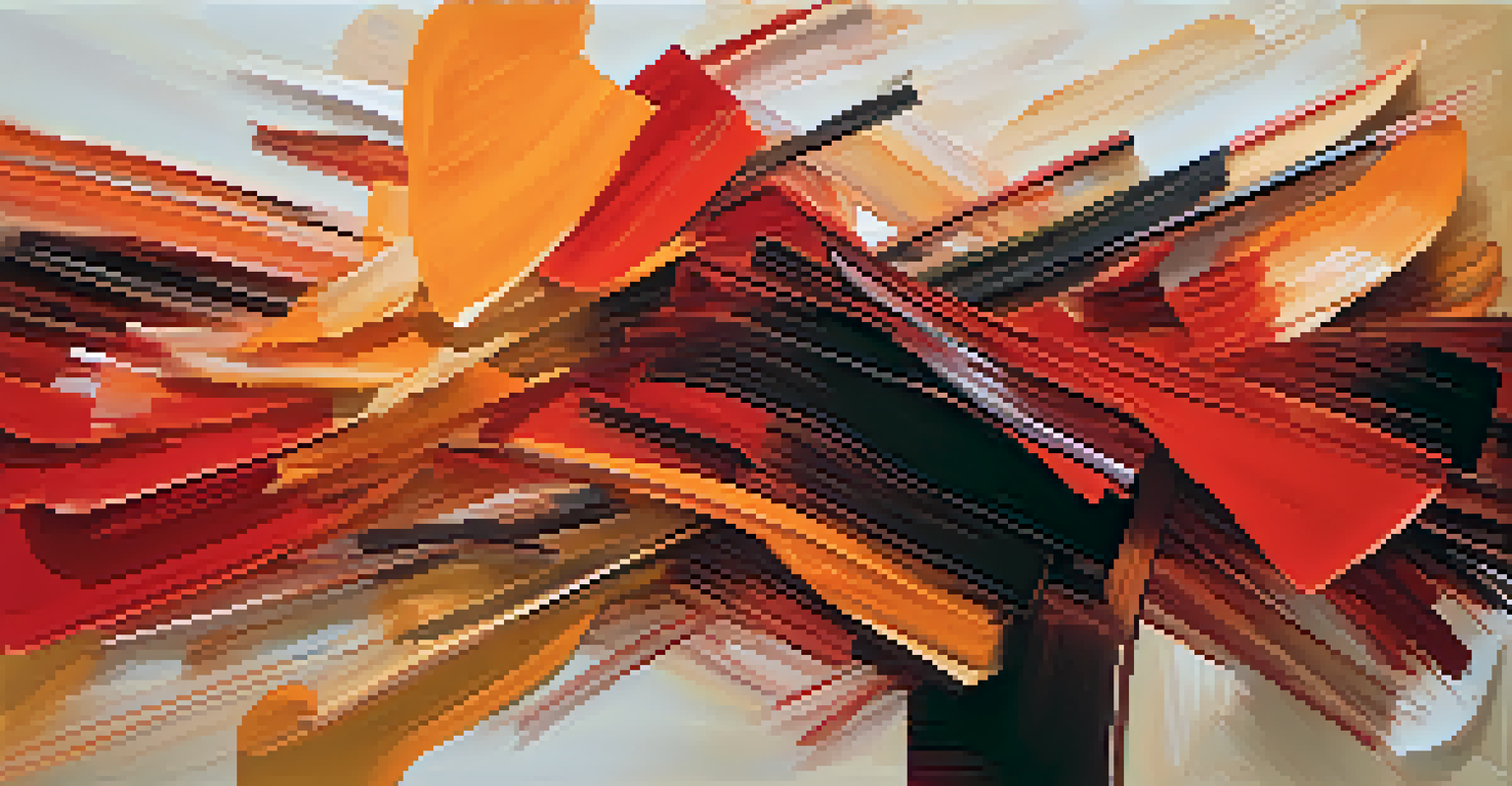The Impact of Brush Strokes on Emotional Expression in Art

Understanding Brush Strokes: The Basics
Brush strokes are the marks left on a canvas by an artist’s brush, and they play a crucial role in conveying emotion. Different techniques can create various textures and shapes, impacting the overall feel of the artwork. For example, a smooth, flowing stroke might evoke calmness, while sharp, jagged lines can convey tension or chaos. It’s fascinating how something as simple as the way a brush touches paint can communicate profound feelings.
The brushstroke is a reflection of the artist's mind.
Artists often experiment with brush strokes to find the best way to express their emotions. Whether it's a gentle touch or a vigorous swipe, each choice reflects the artist's mood and intention. This experimentation allows for a personal connection between the artist and the viewer, making the artwork more relatable. By understanding these elements, viewers can appreciate the depth behind each piece.
In essence, brush strokes are more than just a technique; they are a language of their own. Just like words, they can tell stories and express sentiments that might be difficult to articulate with speech. By recognizing the significance of brush strokes, we open up a new layer of appreciation for art and its emotional resonance.
The Role of Color in Combination with Brush Strokes
While brush strokes lay the foundation for emotional expression, color also plays a vital role. The combination of color and brush technique can amplify the feelings conveyed in a piece. For example, warm colors like reds and yellows used with bold, aggressive strokes can evoke passion or anger, while cool colors like blues and greens paired with soft, flowing strokes may evoke tranquility.

Artists often select their color palette thoughtfully, knowing that colors evoke different psychological responses. The interaction between color and brushwork creates a dynamic relationship that enhances emotional depth. This synergy allows artists to communicate complex emotions in a visual format, making their work resonate more deeply with viewers.
Brush Strokes Convey Emotion
The way brush strokes are applied can evoke a range of emotions, allowing artists to express their feelings and intentions effectively.
By appreciating how color enhances brush strokes, we gain a fuller understanding of the emotional landscape of an artwork. It’s like the harmony in a song; the melody and lyrics work together to create a complete experience. When we recognize this interplay, we can better appreciate the artist’s intentions and the emotions they seek to convey.
Examples of Emotional Expression Through Brush Strokes
Throughout art history, many artists have used brush strokes to express emotions vividly. Take Vincent van Gogh, for example; his swirling, thick strokes in 'Starry Night' convey a sense of turbulence and passion. Each brushstroke seems to pulse with energy, reflecting his inner turmoil and fascination with the night sky. This technique allows viewers to feel his emotions almost as if they are experiencing them firsthand.
Color is the keyboard, the eyes are the harmonies, the soul is the piano with many strings.
Similarly, abstract expressionists like Jackson Pollock utilized chaotic splatters and strokes to express raw emotion. His drip technique created a sense of spontaneity and freedom, capturing feelings of anxiety and excitement. By breaking away from traditional forms, he invited viewers to interpret the emotions embedded in the chaos, creating a deeply personal experience.
These examples illustrate how brush strokes can serve as a powerful tool for emotional expression. Just as a musician uses notes to create a melody, artists use strokes to compose a visual symphony of feelings. By analyzing these techniques, we can better appreciate the emotional narratives woven throughout the artwork.
Cultural Influences on Brush Stroke Techniques
Cultural context significantly influences brush stroke techniques and their emotional meanings. For instance, in East Asian ink painting, the brush stroke is a vital element that embodies the artist's spirit and philosophy. The fluid, deliberate strokes often reflect a connection to nature and tranquility, demonstrating how culture shapes emotional expression in art.
In contrast, Western art movements have embraced more aggressive and dynamic strokes. The Impressionists, for example, used quick, visible brush strokes to capture fleeting moments and emotions, emphasizing the beauty of everyday life. This cultural shift towards spontaneity and emotion showcases how societal values influence artistic techniques.
Color Enhances Emotional Impact
The combination of color and brush techniques creates a dynamic relationship that amplifies the emotional depth of an artwork.
Understanding these cultural influences helps us appreciate the diverse ways emotions are expressed through brush strokes. Each culture brings its unique perspective, enriching the global art landscape. By exploring these differences, we can gain insight into the emotional depth of art across various cultural contexts.
The Psychological Impact of Brush Strokes on Viewers
The way brush strokes are applied can directly impact how viewers feel when they engage with art. Research in psychology suggests that certain brush techniques can evoke specific emotional responses. For instance, energetic, chaotic strokes may create feelings of excitement, while softer, gentler strokes can induce calm. This understanding bridges the gap between art and psychology, revealing the profound effects of visual stimuli.
Artists often intuitively tap into these psychological principles when creating their work. By selecting specific brush techniques, they can guide the viewer's emotional journey. This intentionality allows for a deeper connection, as viewers may find themselves resonating with the emotions the artist intended to convey.
Ultimately, the psychological impact of brush strokes reveals how art can evoke emotions and spark connections. It's a reminder that art is not just about aesthetics; it's also about the feelings it can inspire. By recognizing this impact, we can approach art with a greater sense of awareness and appreciation.
Techniques for Artists to Enhance Emotional Expression
For artists looking to enhance emotional expression through brush strokes, there are several techniques to explore. Experimenting with varying pressure and speed while painting can create different emotional effects. For example, quick, vigorous strokes can evoke urgency, while slow, deliberate strokes may suggest contemplation. This experimentation can lead to a more profound emotional resonance in their work.
Additionally, incorporating mixed media can add another layer of depth to brush strokes. By combining different materials, such as charcoal or pastels, artists can create texture and contrast that enhances emotional expression. This allows for greater versatility in conveying feelings, encouraging artists to push their creative boundaries.
Cultural Context Shapes Techniques
Cultural influences significantly affect brush stroke techniques and their emotional meanings, enriching the global art landscape.
Ultimately, artists should embrace their unique style and intuition when it comes to brush strokes. There are no strict rules, and the freedom to express emotions authentically can lead to more impactful artwork. By prioritizing emotional expression, artists can create pieces that resonate deeply with viewers, fostering a meaningful connection.
The Future of Brush Strokes in Emotional Art
As technology advances, the future of brush strokes in emotional art is evolving. Digital tools and programs are increasingly allowing artists to experiment with brush strokes in new and innovative ways. For instance, digital painting software can simulate various brush techniques, enabling artists to explore emotions without the constraints of traditional media.
However, while technology offers exciting possibilities, it’s essential to remember the emotional authenticity that traditional brush strokes can convey. Many artists continue to embrace the tactile nature of physical painting, using it as a way to connect with their emotions on a deeper level. This balance between tradition and innovation is shaping the future of emotional expression in art.

By blending traditional techniques with modern advancements, artists can continue to push the boundaries of emotional expression. The evolution of brush strokes will undoubtedly lead to new forms of creativity and connection, ensuring that art remains a powerful medium for conveying feelings in our ever-changing world.